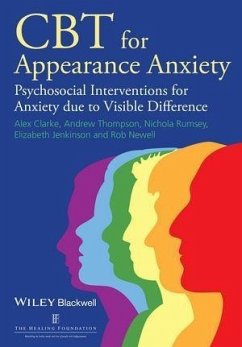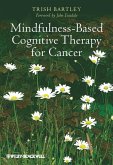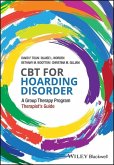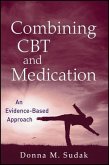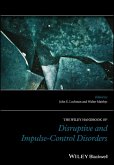CBT for Appearance Anxiety (eBook, ePUB)
Psychosocial Interventions for Anxiety due to Visible Difference


Alle Infos zum eBook verschenken

CBT for Appearance Anxiety (eBook, ePUB)
Psychosocial Interventions for Anxiety due to Visible Difference
- Format: ePub
- Merkliste
- Auf die Merkliste
- Bewerten Bewerten
- Teilen
- Produkt teilen
- Produkterinnerung
- Produkterinnerung

Hier können Sie sich einloggen

Bitte loggen Sie sich zunächst in Ihr Kundenkonto ein oder registrieren Sie sich bei bücher.de, um das eBook-Abo tolino select nutzen zu können.
This clinical manual provides a CBT-based psychosocial intervention for use with individuals distressed about their appearance due to a disfigurement from birth, accident or illness, or those coping with another visible difference. * Contains a wealth of case material with specific relevance to physical health conditions that affect appearance, practical advice on assessment, and session-by-session guidance for addressing common issues * Written by leading academics and clinicians working in the management of disfigurement and rational appearance anxiety * Uses a flexible stepped-care model…mehr
- Geräte: eReader
- mit Kopierschutz
- eBook Hilfe
- Größe: 3.76MB
![CBT for Chronic Pain and Psychological Well-Being (eBook, ePUB) CBT for Chronic Pain and Psychological Well-Being (eBook, ePUB)]() Mark CarlsonCBT for Chronic Pain and Psychological Well-Being (eBook, ePUB)38,99 €
Mark CarlsonCBT for Chronic Pain and Psychological Well-Being (eBook, ePUB)38,99 €![Mindfulness-Based Cognitive Therapy for Cancer (eBook, ePUB) Mindfulness-Based Cognitive Therapy for Cancer (eBook, ePUB)]() Trish BartleyMindfulness-Based Cognitive Therapy for Cancer (eBook, ePUB)45,99 €
Trish BartleyMindfulness-Based Cognitive Therapy for Cancer (eBook, ePUB)45,99 €![The Handbook of Behavioral Medicine (eBook, ePUB) The Handbook of Behavioral Medicine (eBook, ePUB)]() David I. MostofskyThe Handbook of Behavioral Medicine (eBook, ePUB)356,99 €
David I. MostofskyThe Handbook of Behavioral Medicine (eBook, ePUB)356,99 €![CBT for Hoarding Disorder (eBook, ePUB) CBT for Hoarding Disorder (eBook, ePUB)]() David F. TolinCBT for Hoarding Disorder (eBook, ePUB)44,99 €
David F. TolinCBT for Hoarding Disorder (eBook, ePUB)44,99 €![Combining CBT and Medication (eBook, ePUB) Combining CBT and Medication (eBook, ePUB)]() Donna M. SudakCombining CBT and Medication (eBook, ePUB)53,99 €
Donna M. SudakCombining CBT and Medication (eBook, ePUB)53,99 €![Managing Tic and Habit Disorders (eBook, ePUB) Managing Tic and Habit Disorders (eBook, ePUB)]() Kieron P. O'ConnorManaging Tic and Habit Disorders (eBook, ePUB)43,99 €
Kieron P. O'ConnorManaging Tic and Habit Disorders (eBook, ePUB)43,99 €![The Wiley Handbook of Disruptive and Impulse-Control Disorders (eBook, ePUB) The Wiley Handbook of Disruptive and Impulse-Control Disorders (eBook, ePUB)]() The Wiley Handbook of Disruptive and Impulse-Control Disorders (eBook, ePUB)145,99 €
The Wiley Handbook of Disruptive and Impulse-Control Disorders (eBook, ePUB)145,99 €-
-
-
Dieser Download kann aus rechtlichen Gründen nur mit Rechnungsadresse in A, B, BG, CY, CZ, D, DK, EW, E, FIN, F, GR, HR, H, IRL, I, LT, L, LR, M, NL, PL, P, R, S, SLO, SK ausgeliefert werden.
- Produktdetails
- Verlag: John Wiley & Sons
- Seitenzahl: 320
- Erscheinungstermin: 28. Oktober 2013
- Englisch
- ISBN-13: 9781118523414
- Artikelnr.: 39936741
- Verlag: John Wiley & Sons
- Seitenzahl: 320
- Erscheinungstermin: 28. Oktober 2013
- Englisch
- ISBN-13: 9781118523414
- Artikelnr.: 39936741
- Herstellerkennzeichnung Die Herstellerinformationen sind derzeit nicht verfügbar.
Preface xvi
1 Background, Clinical Problems, Common Presentation and Treatment
Considerations 1
Physical and Treatment-Related Factors 3
Socio-Cultural Factors 3
Psychological Factors and Processes 3
Body Image Disturbance 3
Clinical Problems and Presentation 4
Common Features in Referral 8
Visibility of Condition 8
Shame 9
The Meaning of Visible Difference 9
The Experience of Loss 9
Physiological Responses 10
Culture 10
Gender 11
Age 11
Expectations of Treatment 11
Association of Physical Change with Psychological Outcome 12
Fix It Solutions 12
Treatment Considerations 13
2 A Stepped-Care Approach to Psychosocial Intervention 15
The PLISSIT Model 16
Level 1: Permission 16
Level 2: Limited Information 18
Level 3: Specific Suggestions 18
Level 4: Intensive Treatment 19
3 Models and Frameworks: Expanding the Conceptual Approach to Managing
Appearance-Related Distress 21
Explanation for Choice of Therapeutic Approach 22
Behavioural Approaches: Fear Avoidance and Social Skills Training 22
Building an Evidence Base 25
Cognitive Approaches: Comparison of Appearance Anxiety and Social Phobia 26
Use of Safety Behaviours 28
Anticipatory and Post-Event Processing 29
The Role of Assumptions and Schema in Appearance Anxiety 32
Summary 33
Deriving a Cognitive Behavioural Treatment Model: Identifying Factors and
Processes
Contributing to Successful Adjustment to Disfiguring Conditions 34
Working Framework of Adjustment to Disfiguring Conditions 34
The ARC Framework of Adjustment to Disfiguring Conditions 34
Predisposing Factors 35
Intervening Cognitive Processing 36
Socio-Cognitive Processing 37
Outcomes 41
The ARC Research Programme Findings 43
The Studies 43
Summary of Findings 43
Key Messages from the Research Programme 45
Implication of These Findings for Design of Interventions 45
Summary 47
4 Clinical Assessment 48
Eliciting the Problem 49
Summarizing 51
Motivation and Self-Efficacy 52
Readiness for Change 53
Measurement Tools 55
Generic Measures of Psychological Constructs (as used in the ARC Study) 55
Measures of Psychological Constructs Specifically Related to Appearance 57
Measures of Body Image 58
Measures of Psychological Constructs Specifically Related to a Condition
Type 58
Body Dysmorphic Disorder (BDD) 59
Core Clinical Dataset 59
Regular Subjective Measures of Frequency for Events, Thoughts and Feelings
60
Goal Setting 61
The SMART Acronym 61
Challenges in Treatment for Appearance-Related Problems 62
Introducing a Biopsychosocial Model 62
Treatment 'buy-in' 63
5 Social Skills and Coping Strategies 64
Staring, Questions, Comments and Loss of Anonymity 66
Making the Most of Appearance 66
Developing a Positive Approach to Visible Difference 67
Posture, Smiling and Eye Contact 67
Developing Verbal Skills 68
Learning to Have a Conversation 68
Answering Questions About Appearance 68
Managing Staring 70
Putting it into Practice 71
Taking the Initiative in Social Encounters 72
Managing Anger and Developing Assertiveness 73
Anger 73
Managing Intimacy 75
Disclosing a Disfiguring Condition to a Partner 75
Summary 77
6 Cognitive Behavioural Therapy 78
Techniques in Cognitive Behavioural Therapy 79
Socratic Dialogue 79
Eliciting Negative Automatic Thoughts 82
Unhelpful Beliefs Record Form 84
Negative Automatic Thinking Styles Associated with Anxiety 84
Triple Column Technique 87
Pie Charts 87
Manipulating Safety Behaviours 88
Anxiety management techniques 88
Target, Tools, Troubleshoot, Test 89
Cost-Benefit Analyses 90
Some Techniques for Dealing with Appearance-Related Self-Criticism and
Shame 93
Functional Analysis of Self-Criticism 94
Identifying the power of self-criticism 94
Summary 97
7 Planning Treatment and Sessional Guides 98
Introduction 102
Working at Level 1 102
Working at Level 2 104
Working at Level 3 105
Session 1 106
Structure Outline 106
Working at Level 3 Using FaceIT (www.faceitonline.org.uk) 108
Working at Level 4 using CBT 108
Planning Treatment and Sessional Guides 108
Clinical Examples 112
Example 7.4 112
Session 1 112
Session 2 116
Review Data 116
Set Agenda 116
Restatement of Formulation 117
Elicit Patient Understanding 118
Session 3 118
Review of Homework and Reformulation 118
Set Agenda 119
Introduction to Answering Questions About Her Face 119
Role of Self-Focused Attention Discussed 119
TTTT 119
Homework 119
Session 4 119
Review of Homework and Reformulation 119
Set Agenda 120
Reattribution of Beliefs 120
Design Behavioural Experiments 121
Homework 121
Session 5 121
Review of Homework 121
Set Agenda 121
Strategies for Attentional Training 122
Development of Personal Coping Approaches 122
Homework 122
Session 6 122
Review of Homework 122
Measure Noticeability and Worry 122
Reattribution of Beliefs 122
Feedback from Behavioural Experiments 122
Development of Personal Coping Approaches 123
Homework 123
Session 7 123
Review of Homework 123
Set Agenda 123
Schema-Focused Reattribution 123
Preparation for Ending 123
Homework 123
Session 8 124
Review of Homework 124
Schema-Focused Reattribution 124
Planning for Ending 124
Homework 124
Session 9 124
Homework 124
Agenda 124
Outcome 125
Example 7.5 126
Session 1 126
Summary 129
Session 2 130
Review Data 130
Introduction to Social Comparison Processes 130
Restatement of Formulation 130
Elicit Patient Understanding 131
Introduction to Compassionate Thinking 132
Homework 132
Session 3 132
Review of Homework and Reformulation 132
Set Agenda 132
TTTT 132
Introduction to NATs 132
Section 4 133
Review of Homework and Reformulation 134
Set Agenda 134
Reattribution of Beliefs 136
Design Behavioural Experiments 136
Session 5 137
Review of Homework and Reformulation 137
Set Agenda 137
Session 6 137
Review of Homework and Reformulation 137
Set Agenda and Review Progress 138
Measure Noticeability and Worry 138
Reattribution of Beliefs 138
Feedback from Behavioural Experiments (Disclosure) 138
Homework 138
Sessions 7, 8 and 9 138
Review of Homework and Development of Final Reformulation (See Figure 7.13)
138
Set Agenda 139
Focus on Schema-Focused Reattribution 139
Session 10 140
Outcome 140
Example 7.6 140
Session 1 140
Summary 144
Session 2 144
Review Data 144
Noticeability and Worry Graph 145
Set Agenda 145
Introduction to Social Comparison Processes 146
Self-Efficacy 146
Safety Behaviours 146
Restatement of Formulation 146
Homework 147
Session 3 147
Review of Homework and Reformulation 147
Set Agenda 147
TTTT 147
Anxiety Management 148
Introduction to NATs 148
Homework 148
Session 4 148
Review of Homework and Reformulation 148
Set Agenda 148
Design Behavioural Experiments 149
Homework 149
Session 5 149
Review of Homework 149
Set Agenda 149
Homework 149
Session 6 150
Review of Homework 150
Set Agenda 150
Measure Noticeability and Worry 150
Design of Behavioural Experiments 151
TTTT: Role Play Her Response If Her Breasts Are Mentioned 151
Homework 151
Session 7 151
Review of Homework 151
Set Agenda 151
Focus on Reattribution 151
Preparation for Ending 152
Homework 152
Sessions 8, 9 and 10 152
Session 11 152
Homework 154
Agenda 154
Outcome 154
Example 7.7 154
Session 1 154
Summary 157
Session 2 157
Review Data 157
Plan Homework 158
Therapeutic Buddy 158
Homework 158
Session 3 158
Review of Homework and Reformulation 158
Homework 159
Session 4 160
Review of Homework and Reformulation 160
Set Agenda 160
Set Homework 160
Session 5 160
Review of Homework 160
Set Agenda 160
Homework 161
Session 6 161
Review of Homework and Reformulation 161
Set Agenda 161
Completion of Rating Scales and Outcomes 161
Sessions 7 and 8 161
Set Agenda 161
Session 9 162
Completion of Rating Scales and Outcomes 162
Summary and Feedback 162
Outcome 162
Long-Term Outcome and Maintenance of Change 162
Complete Maintenance 162
Partial Maintenance 163
Slip-Back and Sub-maintenance 163
Slip-Back and Failure 163
Social Support and Therapeutic Partners 164
Summary 164
Additional Resources 165
8 The Emerging Adult: Facilitating Transition from Child to Adult Service
166
Introduction 167
Introducing the Problem of Transition 167
Transition from the Young Person's Perspective 168
Transition from the Parents' Perspective 168
Transition from the Health Professionals' Perspective 168
Guidance for Improving Transitional Care 169
Issues Pertinent to Caring for Young People with Appearance Concerns 170
The Salience of Appearance to Young People 170
Reluctance to Seek or Accept Support 171
Factors that Can Promote Adjustment to a Visible Difference among Young
People 171
Romantic Issues 173
Transition as an Opportunity for Those with a Visible Difference 174
Concluding Remarks 175
9 Psychological Assessment for Cosmetic Surgery 176
Introduction 177
Is Cosmetic Surgery Effective? 177
Access to Surgery in the NHS 178
Psychological Screening by the Surgeon 179
NICE Guidelines 179
Onward Referral 179
What Does the Surgeon Want from a Psychological Assessment? 180
What Does the Patient Want from a Psychological Assessment? 181
A Framework for Psychological Assessment 181
Case Examples 183
Common Problems in Referral 189
Liaising with the GP 189
Health Professionals' Knowledge of Cosmetic Procedures 189
Summary 190
Additional Resources 190
10 Models of Service Delivery 191
Lay-Led Support 192
Specialist Services 192
Outlook 192
Embedded Services 192
Royal Free Hospital, London 192
Access to Psychology Services 192
Access to Mental Health Services 193
Mapping Service Models onto Stepped Care 193
Appendix 194
Resources 272
References 280
Index 293
Preface xvi
1 Background, Clinical Problems, Common Presentation and Treatment
Considerations 1
Physical and Treatment-Related Factors 3
Socio-Cultural Factors 3
Psychological Factors and Processes 3
Body Image Disturbance 3
Clinical Problems and Presentation 4
Common Features in Referral 8
Visibility of Condition 8
Shame 9
The Meaning of Visible Difference 9
The Experience of Loss 9
Physiological Responses 10
Culture 10
Gender 11
Age 11
Expectations of Treatment 11
Association of Physical Change with Psychological Outcome 12
Fix It Solutions 12
Treatment Considerations 13
2 A Stepped-Care Approach to Psychosocial Intervention 15
The PLISSIT Model 16
Level 1: Permission 16
Level 2: Limited Information 18
Level 3: Specific Suggestions 18
Level 4: Intensive Treatment 19
3 Models and Frameworks: Expanding the Conceptual Approach to Managing
Appearance-Related Distress 21
Explanation for Choice of Therapeutic Approach 22
Behavioural Approaches: Fear Avoidance and Social Skills Training 22
Building an Evidence Base 25
Cognitive Approaches: Comparison of Appearance Anxiety and Social Phobia 26
Use of Safety Behaviours 28
Anticipatory and Post-Event Processing 29
The Role of Assumptions and Schema in Appearance Anxiety 32
Summary 33
Deriving a Cognitive Behavioural Treatment Model: Identifying Factors and
Processes
Contributing to Successful Adjustment to Disfiguring Conditions 34
Working Framework of Adjustment to Disfiguring Conditions 34
The ARC Framework of Adjustment to Disfiguring Conditions 34
Predisposing Factors 35
Intervening Cognitive Processing 36
Socio-Cognitive Processing 37
Outcomes 41
The ARC Research Programme Findings 43
The Studies 43
Summary of Findings 43
Key Messages from the Research Programme 45
Implication of These Findings for Design of Interventions 45
Summary 47
4 Clinical Assessment 48
Eliciting the Problem 49
Summarizing 51
Motivation and Self-Efficacy 52
Readiness for Change 53
Measurement Tools 55
Generic Measures of Psychological Constructs (as used in the ARC Study) 55
Measures of Psychological Constructs Specifically Related to Appearance 57
Measures of Body Image 58
Measures of Psychological Constructs Specifically Related to a Condition
Type 58
Body Dysmorphic Disorder (BDD) 59
Core Clinical Dataset 59
Regular Subjective Measures of Frequency for Events, Thoughts and Feelings
60
Goal Setting 61
The SMART Acronym 61
Challenges in Treatment for Appearance-Related Problems 62
Introducing a Biopsychosocial Model 62
Treatment 'buy-in' 63
5 Social Skills and Coping Strategies 64
Staring, Questions, Comments and Loss of Anonymity 66
Making the Most of Appearance 66
Developing a Positive Approach to Visible Difference 67
Posture, Smiling and Eye Contact 67
Developing Verbal Skills 68
Learning to Have a Conversation 68
Answering Questions About Appearance 68
Managing Staring 70
Putting it into Practice 71
Taking the Initiative in Social Encounters 72
Managing Anger and Developing Assertiveness 73
Anger 73
Managing Intimacy 75
Disclosing a Disfiguring Condition to a Partner 75
Summary 77
6 Cognitive Behavioural Therapy 78
Techniques in Cognitive Behavioural Therapy 79
Socratic Dialogue 79
Eliciting Negative Automatic Thoughts 82
Unhelpful Beliefs Record Form 84
Negative Automatic Thinking Styles Associated with Anxiety 84
Triple Column Technique 87
Pie Charts 87
Manipulating Safety Behaviours 88
Anxiety management techniques 88
Target, Tools, Troubleshoot, Test 89
Cost-Benefit Analyses 90
Some Techniques for Dealing with Appearance-Related Self-Criticism and
Shame 93
Functional Analysis of Self-Criticism 94
Identifying the power of self-criticism 94
Summary 97
7 Planning Treatment and Sessional Guides 98
Introduction 102
Working at Level 1 102
Working at Level 2 104
Working at Level 3 105
Session 1 106
Structure Outline 106
Working at Level 3 Using FaceIT (www.faceitonline.org.uk) 108
Working at Level 4 using CBT 108
Planning Treatment and Sessional Guides 108
Clinical Examples 112
Example 7.4 112
Session 1 112
Session 2 116
Review Data 116
Set Agenda 116
Restatement of Formulation 117
Elicit Patient Understanding 118
Session 3 118
Review of Homework and Reformulation 118
Set Agenda 119
Introduction to Answering Questions About Her Face 119
Role of Self-Focused Attention Discussed 119
TTTT 119
Homework 119
Session 4 119
Review of Homework and Reformulation 119
Set Agenda 120
Reattribution of Beliefs 120
Design Behavioural Experiments 121
Homework 121
Session 5 121
Review of Homework 121
Set Agenda 121
Strategies for Attentional Training 122
Development of Personal Coping Approaches 122
Homework 122
Session 6 122
Review of Homework 122
Measure Noticeability and Worry 122
Reattribution of Beliefs 122
Feedback from Behavioural Experiments 122
Development of Personal Coping Approaches 123
Homework 123
Session 7 123
Review of Homework 123
Set Agenda 123
Schema-Focused Reattribution 123
Preparation for Ending 123
Homework 123
Session 8 124
Review of Homework 124
Schema-Focused Reattribution 124
Planning for Ending 124
Homework 124
Session 9 124
Homework 124
Agenda 124
Outcome 125
Example 7.5 126
Session 1 126
Summary 129
Session 2 130
Review Data 130
Introduction to Social Comparison Processes 130
Restatement of Formulation 130
Elicit Patient Understanding 131
Introduction to Compassionate Thinking 132
Homework 132
Session 3 132
Review of Homework and Reformulation 132
Set Agenda 132
TTTT 132
Introduction to NATs 132
Section 4 133
Review of Homework and Reformulation 134
Set Agenda 134
Reattribution of Beliefs 136
Design Behavioural Experiments 136
Session 5 137
Review of Homework and Reformulation 137
Set Agenda 137
Session 6 137
Review of Homework and Reformulation 137
Set Agenda and Review Progress 138
Measure Noticeability and Worry 138
Reattribution of Beliefs 138
Feedback from Behavioural Experiments (Disclosure) 138
Homework 138
Sessions 7, 8 and 9 138
Review of Homework and Development of Final Reformulation (See Figure 7.13)
138
Set Agenda 139
Focus on Schema-Focused Reattribution 139
Session 10 140
Outcome 140
Example 7.6 140
Session 1 140
Summary 144
Session 2 144
Review Data 144
Noticeability and Worry Graph 145
Set Agenda 145
Introduction to Social Comparison Processes 146
Self-Efficacy 146
Safety Behaviours 146
Restatement of Formulation 146
Homework 147
Session 3 147
Review of Homework and Reformulation 147
Set Agenda 147
TTTT 147
Anxiety Management 148
Introduction to NATs 148
Homework 148
Session 4 148
Review of Homework and Reformulation 148
Set Agenda 148
Design Behavioural Experiments 149
Homework 149
Session 5 149
Review of Homework 149
Set Agenda 149
Homework 149
Session 6 150
Review of Homework 150
Set Agenda 150
Measure Noticeability and Worry 150
Design of Behavioural Experiments 151
TTTT: Role Play Her Response If Her Breasts Are Mentioned 151
Homework 151
Session 7 151
Review of Homework 151
Set Agenda 151
Focus on Reattribution 151
Preparation for Ending 152
Homework 152
Sessions 8, 9 and 10 152
Session 11 152
Homework 154
Agenda 154
Outcome 154
Example 7.7 154
Session 1 154
Summary 157
Session 2 157
Review Data 157
Plan Homework 158
Therapeutic Buddy 158
Homework 158
Session 3 158
Review of Homework and Reformulation 158
Homework 159
Session 4 160
Review of Homework and Reformulation 160
Set Agenda 160
Set Homework 160
Session 5 160
Review of Homework 160
Set Agenda 160
Homework 161
Session 6 161
Review of Homework and Reformulation 161
Set Agenda 161
Completion of Rating Scales and Outcomes 161
Sessions 7 and 8 161
Set Agenda 161
Session 9 162
Completion of Rating Scales and Outcomes 162
Summary and Feedback 162
Outcome 162
Long-Term Outcome and Maintenance of Change 162
Complete Maintenance 162
Partial Maintenance 163
Slip-Back and Sub-maintenance 163
Slip-Back and Failure 163
Social Support and Therapeutic Partners 164
Summary 164
Additional Resources 165
8 The Emerging Adult: Facilitating Transition from Child to Adult Service
166
Introduction 167
Introducing the Problem of Transition 167
Transition from the Young Person's Perspective 168
Transition from the Parents' Perspective 168
Transition from the Health Professionals' Perspective 168
Guidance for Improving Transitional Care 169
Issues Pertinent to Caring for Young People with Appearance Concerns 170
The Salience of Appearance to Young People 170
Reluctance to Seek or Accept Support 171
Factors that Can Promote Adjustment to a Visible Difference among Young
People 171
Romantic Issues 173
Transition as an Opportunity for Those with a Visible Difference 174
Concluding Remarks 175
9 Psychological Assessment for Cosmetic Surgery 176
Introduction 177
Is Cosmetic Surgery Effective? 177
Access to Surgery in the NHS 178
Psychological Screening by the Surgeon 179
NICE Guidelines 179
Onward Referral 179
What Does the Surgeon Want from a Psychological Assessment? 180
What Does the Patient Want from a Psychological Assessment? 181
A Framework for Psychological Assessment 181
Case Examples 183
Common Problems in Referral 189
Liaising with the GP 189
Health Professionals' Knowledge of Cosmetic Procedures 189
Summary 190
Additional Resources 190
10 Models of Service Delivery 191
Lay-Led Support 192
Specialist Services 192
Outlook 192
Embedded Services 192
Royal Free Hospital, London 192
Access to Psychology Services 192
Access to Mental Health Services 193
Mapping Service Models onto Stepped Care 193
Appendix 194
Resources 272
References 280
Index 293
